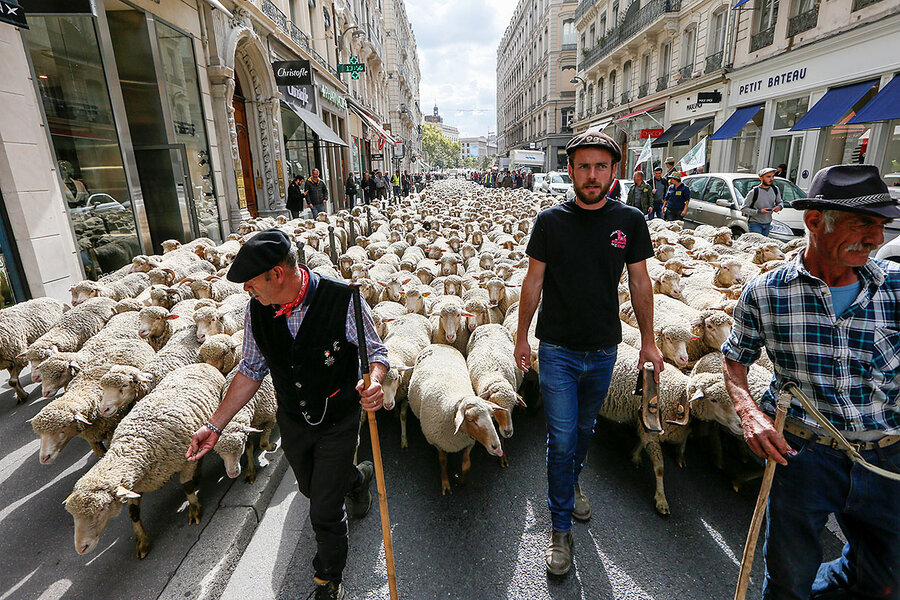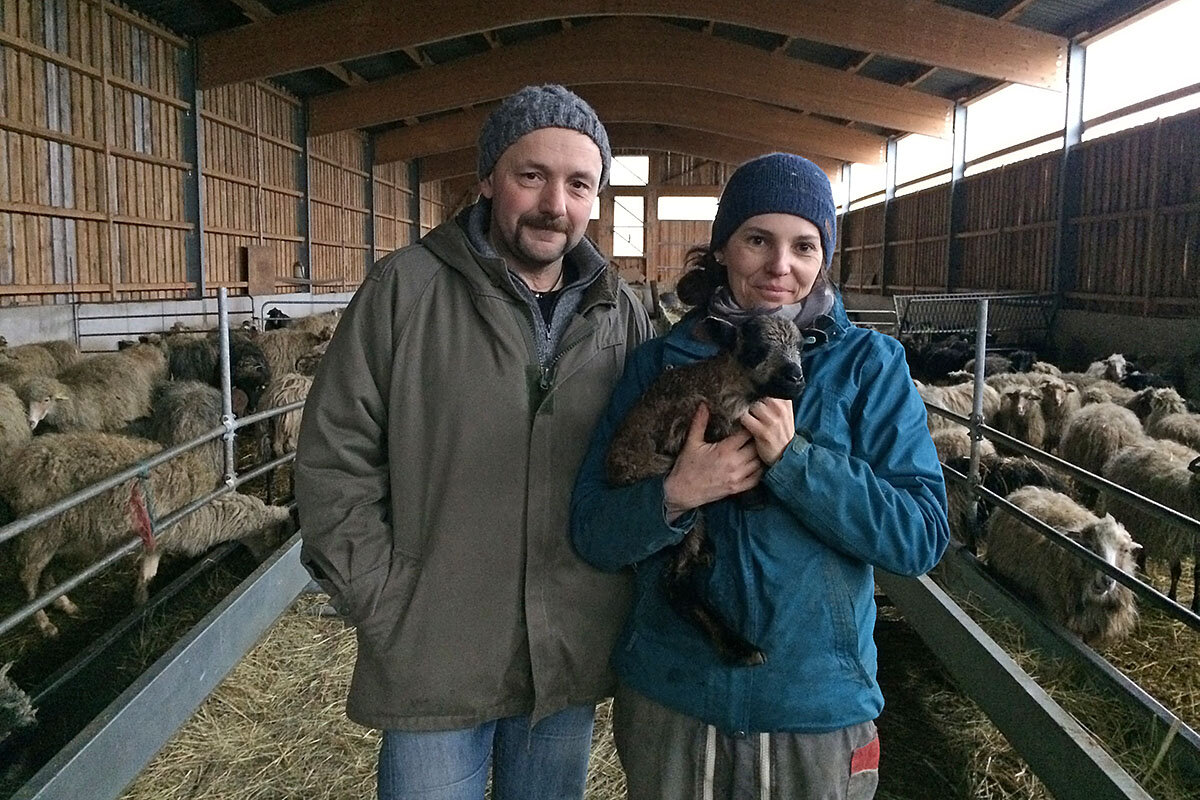France's wolves are back. Now, can it protect its farmers?
Loading...
| Dombrot-le-Sec, France
An icy rain whips through Benoît Gille’s wild gray hair as he rounds up his herd of 400 sheep with his wife, Ghislaine. Mud clinging to their boots, the couple pour hay into several troughs in fields tucked among the rolling green hills of the Vosges region in eastern France.
It’s a picturesque, peaceful country scene – for now. But the threat of a wolf attack is always looming. Despite protective fencing and seven guard dogs, the Gilles have lost more than 60 sheep to wolf attacks in the last year, causing intense emotional and financial strain that has almost broken them.
“When it was really bad a few months ago, there was constant stress that we’d go to the herd and find wounded or dead animals,” says Mr. Gille. The sheep weren’t eating and the pregnant females were losing their lambs due to the stress of seeing other sheep attacked. One day, he says, he went home for lunch and when he came back to the herd, there had been another wolf attack. So the couple started sleeping with the sheep at night in the middle of winter.
“It was even worse when we were further afield because if we brought the herd home, there would be no food for them, but if we stayed, we risked more attacks,” says Ms. Gille. “We were completely overwhelmed and didn’t know what to do.”
The restoration and growth of France’s wolf population, in large part due to the 1979 Convention of Bern which protects them, has been a conservation success story. But as the number of wolves increase in France, so too have attacks on livestock – primarily sheep – leaving farmers little recourse when faced with immediate attacks. The government responded in late February with a strategic plan to handle the return of the wolves, but their attempt at a solution has inevitably pitted animal rights groups against France’s farming community.
While those fighting for animal protections say the government’s plan doesn’t allow for a peaceful coexistence between farmers and wolves, farmers say the law doesn’t have their interests at heart. They see the government as ultimately choosing the wolves over their livelihood – a livelihood that threatens to disappear if a solution cannot be found.
“The wolf situation reflects the overall anger of the rural population,” says Jean-Christophe Bureau, a professor of economic and agricultural policy at AgroParis Tech. “For the last ten years, farmers feel that the government is putting the interests of the wolves before theirs.”
Wolves are back
The gray wolf has long held a prominent role in the French imagination and remains a recurring figure in French children’s fables. Despite how few attacks were committed against humans, France began a systematic extermination of the gray wolf starting in the Middle Ages, and a law in 1882 called for their total obliteration. By 1940, wolves had completely disappeared from French territory. Just a small population in Spain and Italy prevented their total disappearance from Europe.
Wolves gradually made their return to France in 1992 when they passed naturally through the Italian Alps. In the last five years, the number of wolves in France has exploded, with 360 wolf sightings reported in France in 2017 and nearly 300 the previous year. While the area surrounding the Alps has seen the highest numbers, wolves have been spotted in all corners of the country and increasingly found in more densely populated zones.
“There was a wolf attack in a town near us, 50 meters from the local church,” says Marc Baudrey, a sheep farmer from the town of Fresse-sur-Moselle – two hours from the Gilles’ – who nearly lost his own farm in 2015 after a series of wolf attacks. “A majority of the attacks are when sheep are protected by humans, day or night. Wolves are not afraid of humans, they’re not afraid of anything.”
In addition to tending to his 200 sheep with his wife, Ludivyne, Mr. Baudrey heads up a special division on livestock attacks with the national farmer’s union Confédération Paysanne, crossing the nation to speak to other farmers and lawmakers about how to deal with the wolves. He’s stopped by Dombrot-le-Sec to speak to the Gilles about their situation and provide support, before heading to Paris to speak out about a government plan that he says doesn’t adequately protect farmers.
The current dossier allows a maximum of 40 wolves to be killed per year. The controlled kills can only take place between September and December, and farmers must notify the local government before doing so. If they can prove the attacks were indeed committed by a wolf and that they had protective measures in place beforehand – human protection, guard dogs, or electric fencing – then they can qualify for financial compensation for their loss.
But farmers say that local government agents often don’t believe it when they say an attack was committed by a wolf, and when they do, the reimbursements don’t go far enough. Plus, they say, allowing just 40 kills is unrealistic when more than 10,000 sheep were killed by wolves in 2016.
“Each of our sheep cost about 400 euros [$490],” says Benoît, who with Ghislaine raises a type of sheep from Shropshire, England, that offers a refined, lean meat. “The state reimbursed us between 26 and 110 euros [between $32 and $135] for each sheep that was killed by a wolf. So we probably lost about 24,000 euros [$25,000] last year for a total reimbursement of about 1,850 euros [$2,300].”
The sheep farming industry is heavily subsidized in France. For small farms in the Alps, subsidies can rise to 50,000 euros ($61,000) compared to an income of just 20,000 euros ($25,000). Despite the small amount of revenue it brings to the economy and its heavy reliance on government aid, France is still willing to fight for its conservation.
“There are lots of positive externalities to the presence of sheep in France,” says Professor Bureau. “The sheep maintain the countryside by eating the grass, they prevent avalanches and promote tourism to areas that might not get it otherwise.”
The wolf-farmer balance
But some say sheep farmers' priorities have shifted as wolf attacks have increased, throwing into question how much aid they should get.
“Obviously we need to support these farmers financially, whether it’s helping them build fencing or buy guard dogs. But from many we just hear that they want to kill, kill, kill,” says Jean-David Abel, vice president of environmental protection agency France Nature Environnement (FNE). “So some are asking, why should we give them the right to kill wolves if all they want is money?”
Meanwhile, much of the local government is leaning in favor of conservationists, with 75 percent of deputies from President Emmanuel Macron’s party in mountainous zones voting in favor of wolf protection while just 25 percent side with farmers.
France’s farmers have turned to the situation in Wyoming’s Yellowstone National Park as a reference, which has pitted wolf hunters, conservationists, and farmers against each other. Since the gray wolf was reintroduced in 1995, the number of wolves there has increased to 108 in 2016. But unlike in France, wolves were taken off Wyoming’s endangered species list in April 2017, allowing for hunters to have free rein in certain zones.
The wolf issue also comes against the backdrop of a list of grievances from France’s agricultural industry. Ahead of February’s Salon d’Agriculture, an annual fair to show off France’s farming culture, farmers across the country blockaded roads in protest of a bill that would reduce the number of those who qualify to receive European subsidies. In addition, a transatlantic treaty between France and Latin America could increase import prices of meat and, as farmers see it, threaten the country’s meat industry.
“This is more than just about wolves. The sector is anxious about the future,” says Bureau. “In addition, you have public services going down in many rural areas with a lack of schools, doctor’s offices, post offices. There’s a growing anger among the population.”
'We want to live with the wolves'
Out of the crushing cold, Benoît and Ghislaine head back to their farmhouse, where a wood stove warms the mud on their boots to a hardened crust as their dungarees hang to dry after another unforgiving day in the elements. According to government protocol, they’ve trained enough guard dogs and installed electric fencing around their land in hopes it will keep wolves at bay. But at what cost?
“All this talk about fencing is well and good but we have to think about what kind of image we are creating for our farms,” says Ghislaine. “Do we want to continue having free, open spaces or everyone with their own cage, roped in by wire?”
Baudrey, who assures the couple that he’ll bring up their case at the next union meeting, says there are grave consequences if the wolf situation isn’t figured out soon.
“The result is that farmers are simply going to leave this region,” says Baudrey. “The heritage of this area will diminish and future generations will suffer if no one is here to maintain the land.”
The Gilles insist they just want to find some peace and tranquility in their daily lives and have no intention of killing wolves. They don’t even own a gun.
“We are not hunters,” says Benoît. “We don’t want to kill the wolves, we want to live with them. But the current situation is untenable. Where do we go from here?”






